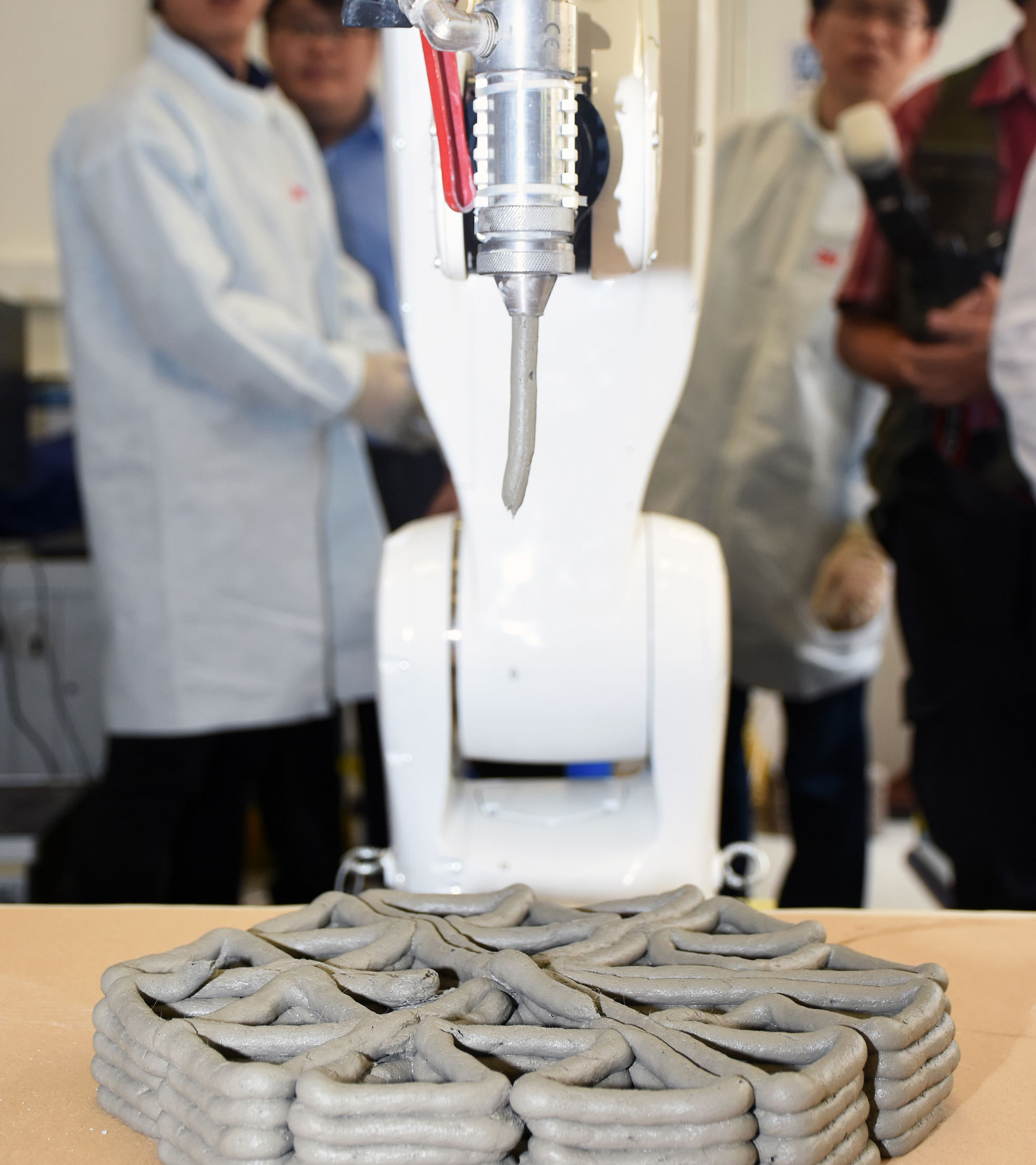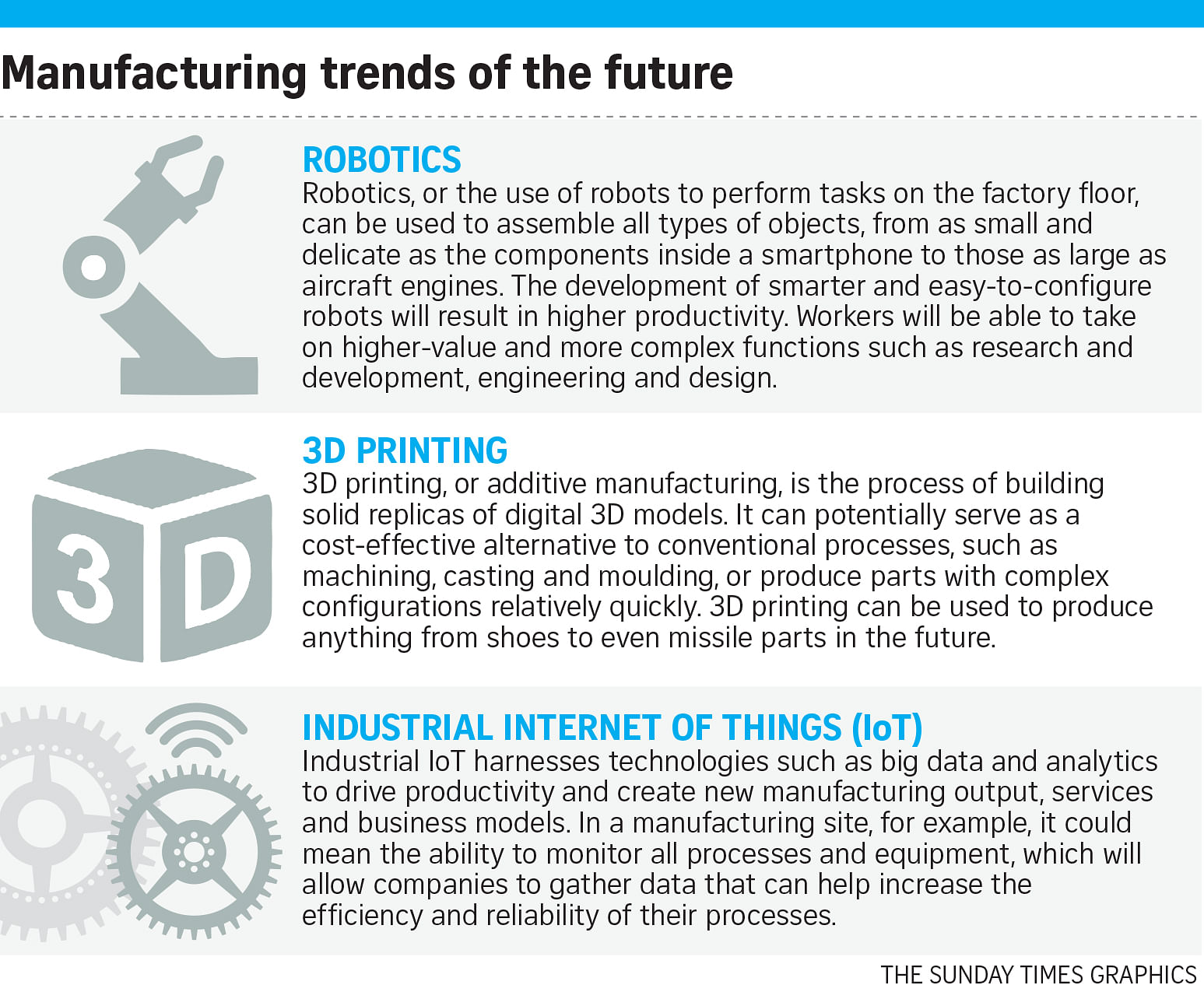-
PANELLISTS
LIM KOK KIANG, assistant managing director, Economic Development Board
RUSSELL THAM, regional president (South-east Asia) and corporate vice-president, Applied Materials
DR RAJ THAMPURAN, managing director, Agency for Science, Technology and Research (A*Star)
DOUGLAS FOO, president, Singapore Manufacturing Federation, founder, Sakae Sushi AARON LOW, deputy business editor, The Straits Times
MODERATOR
LEE SU SHYAN, business editor, The Straits Times
The future of manufacturing in Singapore
Made in S'pore - and beyond
Multi-country tie-ups, cross-sector collaboration, plus jobs that pay well. And a driver of innovation, to boot. Roundtable panellists see a bright future for manufacturing

Images of rows of factory workers huddled over benches and assembling components make Ms Seraphina Seng shudder.
The media contact at the Singapore operations of United States chip equipment-maker Applied Materials says: "That's not how my office looks like, and that's not what manufacturing is."
Cast aside preconceived notions about factories. The Applied Materials facility in Changi, with its bright and open office, spacious meeting rooms and rest areas with plants and cheerful furniture, is a far cry from the images of Singapore's dirty and noisy manufacturing factories of yesteryear.
Today, rather than making components and ball-bearings, the local manufacturing scene features anything from solar panels to medicines by the likes of multinationals Pfizer and GlaxoSmithKline, and Novartis, to oil rigs by Keppel Offshore & Marine.
Indeed, in some cases, there may not even be a factory here at all. While the actual manufacturing is done overseas, increasingly more research and development (R&D) takes place in Singapore. Procter & Gamble - maker of shampoos and soaps - has an innovation centre here that employs 500 engineers, researchers and support staff.

On the other hand, as Singapore became very strong in the electronics sector, manufacturing made up about a quarter of Singapore's economy. Now, its share has fallen to about 20 per cent. After about a year of shrinking production - down 5.2 per cent last year - the sector continues to be hamstrung by a lacklustre global economy. In low-cost markets such as China, wages have risen. Resource prices are volatile, while skilled talent is often in short supply.
So, can manufacturing still be a key pillar of Singapore's economy? And even if it can still hold that position, can Singapore still find a niche for itself? The answers, from the panel of roundtable experts, may be what insiders at the coalface have already gleaned, but will, perhaps, excite others, and spur them to take a fresh look at the economy's workhorse.
REASONS TO CHEER
Manufacturing may be declining as a share of the total economy but it is more than the sum of its parts.
"Manufacturing fundamentally creates value," says Agency for Science, Technology and Research (A*Star) managing director Raj Thampuran. It adds diversity to the economy and makes it more resilient, the panel member adds.
The sector can generate positive spillovers for the rest of the economy, from services such as distribution, transportation and financing, a Ministry of Trade and Industry study has found.

The ministry contrasts a $1 million increase in demand for manufacturing with a similar increase in demand for the darling of the economy, the services sector.
It found that manufacturing demand translates to $81,000 worth of non-manufacturing output and 0.65 non-manufacturing jobs but services generated a lower $22,000 of non-service output and 0.27 non-service jobs.
Manufacturing also does well in terms of a common measure of productivity - value-added per worker. This was 5.9 per cent for the period from 2009 to last year, outstripping the overall economy's 2.2 per cent.
And it creates good jobs for Singaporeans, says another panellist, Economic Development Board (EDB) assistant managing director Lim Kok Kiang. Its mean (or average) wage is around $4,400 for locals, higher than the $3,900 mean across all sectors. The sector also drives innovation, he says. Last year, it accounted for 54 per cent of total private-sector expenditure on R&D.
And while the manufacturing sector's contribution to gross domestic product has dropped, output has been growing over the last 10 years in absolute terms. This helps Singapore's growth in services, too. What this says is that both manufacturing and services have been growing but it is only because the services sector has grown faster that manufacturing's share has correspondingly dropped.
NO HINTERLAND? NO PROBLEM
Mr Lim argues that Singapore starts from a strong base, with a skilled workforce and existing engineering capabilities. "This puts us in a position to seize growth opportunities."
Applied Materials regional president (South-east Asia) Russell Tham says: "We have an advantage (in) that Singapore doesn't rely on one sector. Within manufacturing, there are multiple sectors. Singapore has an established base, whether it's chemical electronics, engineering infocomms or biomedical sciences."
And what were disadvantages previously, such as a shortage of land, are less of an issue now. Mr Tham says: "Some of these latest manufacturing trends, like additive manufacturing (3D printing), are not exactly land intensive."
There are now a rising number of "factory-less good-producing firms". An example would be a semiconductor firm based here that designs semiconductor chips but the actual production is done overseas.
This is a reversal from the days of contract manufacturing in Singapore, when chips were made here but designed elsewhere.
In fact, Singapore Manufacturing Federation president Douglas Foo, who is the founder of the Sakae Sushi chain, says the Asean Economic Community (AEC) - which came into effect in December, and whose policies include free flow of trade- has opened up ways to overcome Singapore's land and labour shortage.
For example, with manufacturing processes that still need labour, Mr Foo's point is that Indonesia can be an alternative location. Singapore firms may not even need to build a facility in the overseas location as there is likely to be enough capacity over there already. Previously, only the lower end of the manufacturing process was outsourced but, these days, often just the research and development aspects are done in Singapore.
"So, Singapore firms can consider how to collaborate with a facility owner who can do that manufacturing aspect, with the final piece coming back to Singapore, then being exported as a product of Singapore, leveraging on the brand that Singapore has, as well as the many free trade agreements that are in place," Mr Foo suggests.
In other words, Singapore should be "taking advantage of the AEC as a large market of consumers as well as a producing hub".
Potentially, technology and the AEC, for example, could soon render the term "resource constraints" irrelevant for Singapore.
With the likes of world-beaters such as oil-rig builder Keppel Offshore & Marine and Sembcorp Marine, Singapore has a lot going for it.
Mr Lim says Singapore and its "peaks of excellence" in semiconductors, aerospace, and marine and offshore sectors creates ample opportunities for collaboration.
He cites the automotive industry, which could learn from the aerospace industry on how to scale up - for example, as more planes get produced - or from the semiconductor industry, which needs to ramp up to produce more chips for phones quickly.
Or take, for instance, Seletar Aerospace Hub, where the likes of aircraft engine maker Rolls-Royce operates. More aerospace manufacturing activities based here will support growth in maintenance, repair and overhaul services.
Mr Lim gives another example of what the offshore and marine sector could learn from the aerospace industry. He says: "Whether it's 30,000 feet above ground or 30,000 feet underground, it is still a harsh environment - high temperatures, high pressure, so there could be things to tap on between the two sectors".
The challenge for the agencies will be to ensure and engineer successful collaborations across different industries.
One model is the Advanced Remanufacturing and Technology Centre, launched last year by A*Star, where different industries collaborate on technologies that can be deployed across multiple sectors. But Mr Lim says other platforms need to be created.
WHAT ABOUT THE FUTURE ECONOMY?
Digital manufacturing, which covers 3D printing and robotics, for example, is changing the face of manufacturing.
It has the potential to make manufacturing more productive, such as carmakers that use computer-aided design to draw up designs for a car, or to capture data on consumers to allow manufacturers to make the products that consumers want, rather than relying on "gut feel".
Mr Lim says that with new products such as smartphones, the pressure is on chipmakers to innovate, by making chips that will go into smaller phones, yet allow for more storage and have more power.
This imperative runs across all sectors, be it in the semiconductor or aerospace sector. In the aerospace sector, for example, every engine has to be more cost-effective, yet of a lower weight and better performance, says Mr Lim.
Mr Foo says with the trend towards hotel operators with no hotels (Airbnb), and transport companies with no vehicles (Uber), business models all need to change, and that goes for the manufacturing sector, too.
For Singapore to continue to thrive, the sector needs to encourage creative and innovative capacities, to build new companies and new industries.
"We have been resourceful in how we have built this country into where it is today," Mr Foo says. "But the next chapter is going to be much more exciting."
VIDEO
Watch highlights of the roundtable discussion: http://str.sg/45Mk
Watch the full discussion here http://str.sg/45MZ
Join ST's Telegram channel and get the latest breaking news delivered to you.
A version of this article appeared in the print edition of The Sunday Times on July 17, 2016, with the headline Made in S'pore - and beyond. Subscribe

